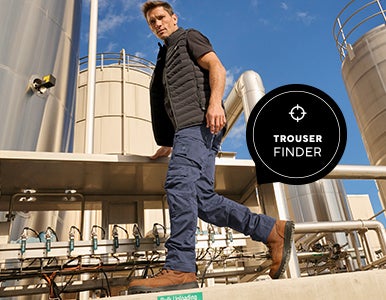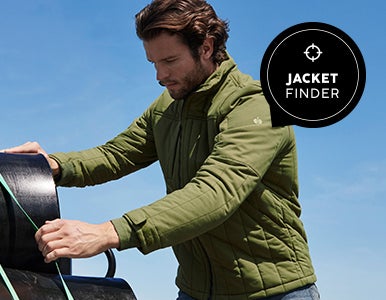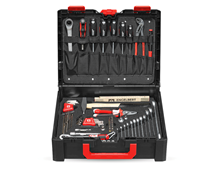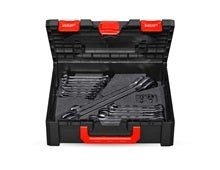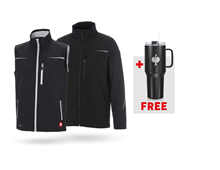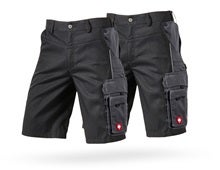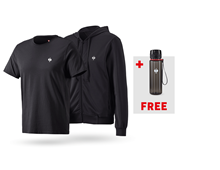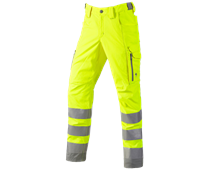EAZYFIT® comfort technology
- very comfortable thanks to innovative waistband technology
- elastic gathers on both sides like an accordion
- the waistband is extremely flexible
- pleasant, secure hold however you move
- no pinching or pressure even in extreme work situations
- has a sporty, modern appearance combined with absolute comfort
EAZYFIT® CLIMATE
Comfort and flexibility based on the accordion principle!
Transfer of the multi-width character to movement-intense zones in the shoulder and back areas. Moves easily with the wearer and adapts ideally to various shoulder widths. Microfine pores ensure better circulation and a pleasant climate inside the garment.
Elastane (EL)
Elastane fibres are highly elastic and can reach up to seven times their original length. After being stretched, the fibres retract to their original length. Usually, the elastane is mixed with other fibres to enhance their properties with the elasticity of elastane. The functional properties of elastane make these highly elastic fibres highly interesting for the sports sector: fast drying, precise fitting and the material keeps its shape. These are exactly the same functions that workwear needs to fulfil. Elastane ensures that our workwear stays in shape and allows absolute flexibility. The combination of cotton and elastane is a guarantee for flexibility and a sense of well-being. The natural benefits of cotton – soft, kind to skin and enormously moisture-absorbing – mixed with elastane and its elastic properties make cotton textiles less likely to crease, and ensure that they are lightweight and fast drying.
Care: Materials that contain elastane should be washed with a mild detergent. Always check the care instructions on the label before drying and ironing.
Elastomultiester (EME)
Synthetically produced fibres that are extremely elastic
Elastomultiester is a generic term for elastic, spun bi-component fibres. The single filaments of these fibres comprise two different partially endless fibres, which in turn are made of two different polyester polymers. This special composition achieves a superior elastic and rebound behaviour. Excellent material stability, low shrinkage, easy-care and wash-and-wear are the greatest advantages of textiles with Elastomultiester. In particular, we produce workwear with Elastomultiester for the gastronomy and health sectors.
EN 343:2003
Weatherproof clothing by Strauss undergoes stringent testing before it is sold. The DIN Norm EN 343:2019 (previously DIN EN 343:2010) ensures that products that are worn every day meet the strictest of standards. The multilevel certification gives the customer proof of the clear and reliable quality features. Two criteria are decisive in the tests: how waterproof and how breathable the material is. Both values are shown on a scale from 1 to 4 and so 4/4 is the best possible result.
Weather protection that feels good
The first value shows the resistance of the jacket to various levels of water pressure, the second value describes the ability of the material to discharge water vapour outwards. Also, the DIN norm checks whether clothing that is worn frequently retains its mechanical properties (stability/robustness). Strauss has a number of certified raincoats and weatherproof trousers that not only keep the wearer dry, but also ensure excellent wearing comfort thanks to the high-performance membranes.
EN 381-5 Cut protection class 1 Form A KWF Profi tested and FPA certified
EN 381-5 Cut protection class 1 Form A KWF Profi tested and FPA certified
e.s. protective clothing according to EN 381-5 protects the wearer against leg injuries resulting from cuts caused by manual chainsaws.
The standard EN 381 defines the special requirements made of protective clothing for users of manual chainsaws; part 5 addresses the specific leg protection requirements.
Cut protection clothing is classified according to chain speeds up to which the protection exists. Cut protection class 1 corresponds to a chain speed of 20 m/s.
The shape of cut protection trousers provides information about the areas of the leg that are to be protected. Shape A is typical for cut protection trousers in the forestry field – the front part of the leg is equipped with cut protection material. Form A: partially protects both feet; the protection starts more than 5 cm above the lower side of the leg and ends at least 20 cm above the crotch seam, goes 5 cm into the inside of the right leg and 5 cm into the outer part of the left leg.
e.s. cut protection trousers bear the KWF Profi symbol and are FPA-certified. Only work equipment and protective clothing that have been fully tested by the Curatorship for Forest Operation and Forestry are given this symbol. They meet all state-of-the-art requirements. This includes efficiency and occupational safety standards, ergonomics and environmental compatibility. The tests comprise extensive technical measurements, forestry application tests and practical surveys. If the result is positive, the responsible test committee makes a decision to award the ‘FPA-recognised’ accreditation.
EN ISO 11393-2
Protective clothing for users of hand-held chain saws – Part 2: Requirements and test methods for leg protectors (ISO 11393-2:2018); German version EN ISO 11393-2:2019
Replaces the previous norm DIN EN 381-5 / the following amendments have been made:
a) Merging of the previously valid norms DIN EN 381-5 and DIN EN 381-2 into one norm
b) Inclusion of new terms in Section 3
c) Revision of Section 4 "Requirements"
d) 6.1.1 "Cleaning" has been completely revised
e) An ergonomics test was added under 6.6
f) Section 7 "Labelling" has been revised
g) The information requirements in Section 8 have been revised
h) Adaption to the current valid design rules
e.s. clima concept
With the e.s. clima concept, you select the ideal thermal level depending on the physical activity. Strauss Functional underwear offers the matching solution whatever the thermal requirements.
ESD
Workplaces that need to be protected against electrostatic charging are marked as Electrostatic Protected Areas or ESD workplaces. The antistatic features, e.g. antistatic workwear or ESD safety shoes, prevent electrostatic charging that is usually caused by static. Based on the latest ESD norms, the maximum allowed electrostatic charging is stated for ESD protection zones. This serves protection against electrostatic discharging that can damage or destroy sensitive electronic parts. Work shoes and safety shoes with ESD features must meet the requirements of DIN EN 61340 with a bleeder in a range of > 0.1 Megaohm (1.0 x 10⁵ Ohm) to < 100 Megaohm (1.0 x 108 Ohm). The EN 1149-5:2008 in conjunction with EN 1149-3:2004 governs the properties of protective clothing with electrostatic properties.


